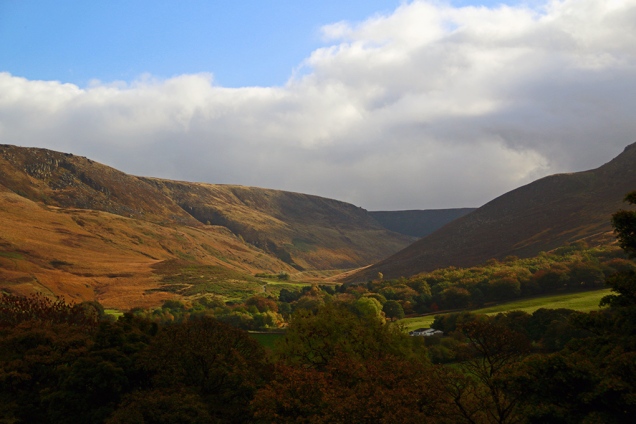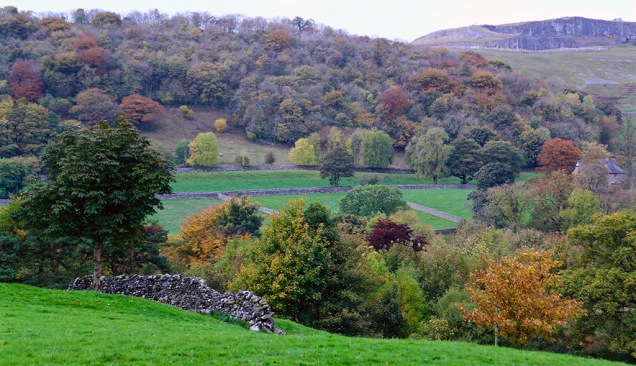 The Dales shower didn’t bother me; I wasn’t cold. There was no fierce easterly wind biting as it did last week. I stood on Winskill Stones and watched a perfect semi-circle rainbow form above Ribblesdale. There was a dusty mist in the valley, dark streaks of rain drifted into the distance as the shower passed through. A grey veil hid Ingleborough’s flat summit.
The Dales shower didn’t bother me; I wasn’t cold. There was no fierce easterly wind biting as it did last week. I stood on Winskill Stones and watched a perfect semi-circle rainbow form above Ribblesdale. There was a dusty mist in the valley, dark streaks of rain drifted into the distance as the shower passed through. A grey veil hid Ingleborough’s flat summit.
The underside of heavy cloud to the west was tinged purple by the glow of a magnificent setting Sun. Just for a few minutes I forgot about problems caused by humans and marvelled at the wonder of a far superior Nature. Too briefly, shades of gold and red filled a stage in the sky. A beautiful Saturday night performance played for the benefit of many but attended by few. And people say they’ll miss Ant & Dec.
A friend asked me to settle an argument about where the River Ribble starts. I’ve been through this before via the blog, with me spouting some high and mighty claptrap about it never starting or finishing, as it is just rain water which heads to the sea, evaporates and falls again.
Not satisfied with my theory I was told to point to a place on a map. Annoying my pal further I insisted that there isn’t one particular source. There are so many tributaries, some just starting out as trickles of water off the highest fells or from springs dotted around the dale.
I’ve read a dozen books in which the authors have put forward arguments for different ‘sources’. There’s a spot on Cam Fell where water can either go east through Wharfedale or west through Ribblesdale; water from Batty Moss can head off to Morecambe Bay via Chapel-le-Dale or join the Ribble for a longer journey west. From up around Newby Head and surrounding fells, water can head down into Wensleydale to the Ure or find its way via various gills to help form the Ribble. Even the mass of Park Fell and Ingleborough on t’ other side of the dale can lay claim to providing a ‘source’ for the Ribble.
 The people at the Ordnance Survey aren’t much help, either. On a Dales map from the mid-1800s (reproduced here) is marked a spring, and beside it is printed ‘Ribble Head’. Later editions of the map don’t include this. In fact, the terms River Ribble and Ribblesdale do not appear on the later versions of the OS map until various water courses have joined forces near Selside.
The people at the Ordnance Survey aren’t much help, either. On a Dales map from the mid-1800s (reproduced here) is marked a spring, and beside it is printed ‘Ribble Head’. Later editions of the map don’t include this. In fact, the terms River Ribble and Ribblesdale do not appear on the later versions of the OS map until various water courses have joined forces near Selside.
We ended up agreeing there are bigger things to worry about in life, like whose round it was.
 I have a treasured signed copy of Bill Mitchell’s book, Summat & Nowt, which is looking a bit tatty now having been read half a dozen times and referred to on numerous more occasions. I’d already known and worked with Bill for about five years when in 1998 he dropped off copies of that newly published book at the Dalesman office. He liked to pop in to talk of journalistic matters and be reminded what life was like ‘at the coal face’, as he would say.
I have a treasured signed copy of Bill Mitchell’s book, Summat & Nowt, which is looking a bit tatty now having been read half a dozen times and referred to on numerous more occasions. I’d already known and worked with Bill for about five years when in 1998 he dropped off copies of that newly published book at the Dalesman office. He liked to pop in to talk of journalistic matters and be reminded what life was like ‘at the coal face’, as he would say.
The book has a chapter called The Long Drag, which is culled from a book he wrote of the same name. It’s a lovely piece on the Settle-Carlisle Railway – not about the intricate technical details the train buffs prefer, or a dry account of its construction and history – but of the characters who brought the line to life. The drivers, signalmen, station masters, tea lady – and a host of other volunteers who dragged the line through its darkest days.
So this week it was a great pleasure to be invited to the unveiling of a plaque at Settle station to commemorate Bill’s contribution to the railway. His son David and daughter Janet gave moving accounts of their dad’s affliction: Settle-Carlilitis. Photo shows David and Janet beside the plaque (yes, it was cold, Janet).
Talking about the Ice age … here’s a good example of how those vertical cracks form and destabilise rock faces (near Ribblehead):
Some more shots taken on a freezing trip around the former quarry at the top of Ribblesdale:
Further into the Dales: I had a quick trip down Widdale into Wensleydale early in the week – stopped to capture snow blowing up Burtersett High Pasture:
Another shot of Ribblehead Viaduct:












































